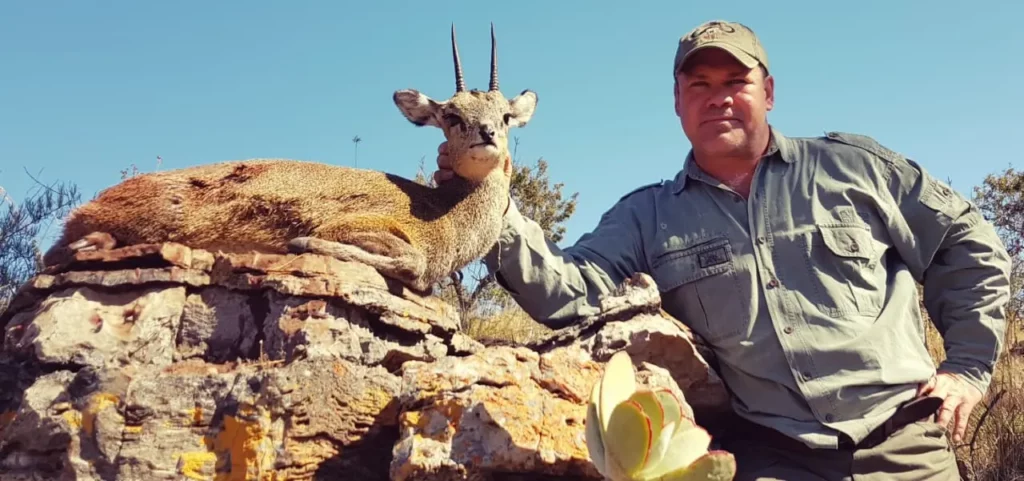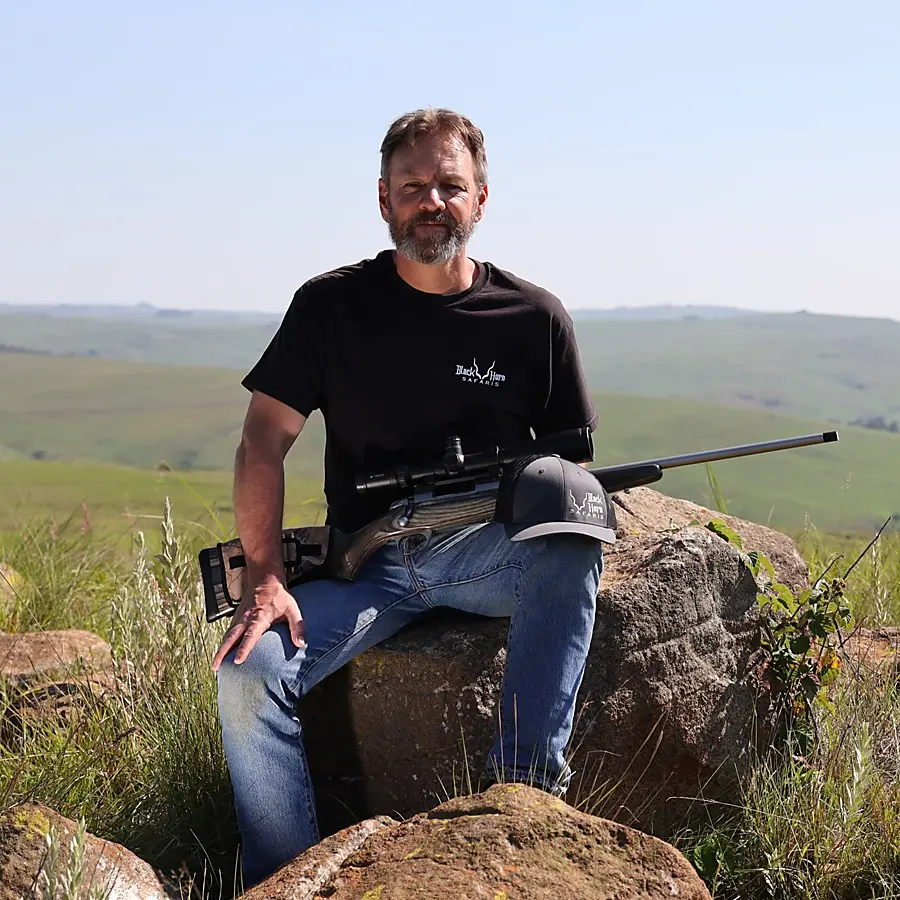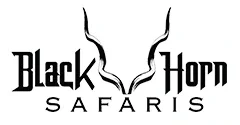A hunt in South Africa for Klipspringer is a challenge that trophy collectors thrive on in the rugged terrain of the African bush. The klipspringer, a small antelope species native to Africa, and is well known for its remarkable agility and unique ability to bounce up steep, rocky cliffs with ease. Their name, derived from the Afrikaans words “klip” (rock) and “spring” (jump), truly captures their exceptional climbing skills. Read on if you are planning an African Safari, we provide information on prices, best areas, rifle calibers and bow hunting for these elusive little buck.


Description and Characteristics of Klipspringer
The klipspringer (Oreotragus oreotragus), is a small and distinctive antelope species endemic to the mountainous regions of Africa. Measuring approximately 20-24 inches at the shoulder and weighing between 22 and 40 pounds, these agile animals have a stocky build with a coarse, speckled coat that varies from yellowish-brown to gray, providing them with natural camouflage in their rocky habitat. One of the most striking features of the klipspringer is their unique, rubbery hooves. Adapted for their preferred terrain, the hooves have a rounded shape and a specialized, elastic pad that allows them to grip onto even the most precarious surfaces with remarkable stability. In addition, klipspringers are known for their monogamous behavior, forming lifelong pairs that maintain a strong bond and rarely stray far from one another.
Klipspringer Trophy Size
Klipspringer trophy size, while relatively modest compared to other African game species, is nonetheless meaningful measure of a successful hunt. A male klipspringer’s horns, which are straight, slender, and slightly divergent, serve as the measure of trophy quality. Typically, their horns range from 3 to 4 1/2 inches in length, with specimens measuring over 4 inches being considered good trophies. However, trophy size alone should not be the sole criterion for assessing a successful klipspringer hunt. The pursuit of this nimble and elusive quarry offers an unparalleled test of a hunter’s skill and endurance in the rugged, mountains of Africa. Rowland Ward minimum for entry into their record book is 4 1/8 inches and Safari club International a score of 10.
World Record
The world record klipspringer, with an impressive horn length of 6 6/16 inches is acknowledged by the Rowland Ward records of Big Game. These huge horns indicate the incredible potential of this unique African species, known for its remarkable agility in rocky terrains.
Best Locations for Klipspringer Hunts in South Africa
South Africa includes a number different of habitats, making it the ideal destination for klipspringer hunting. While the country offers numerous locations for pursuing this agile antelope, certain areas are particularly known for their thriving klipspringer populations. The Limpopo Province, situated in the northernmost part of South Africa, is one such area, featuring vast expanses of mountainous bushveld that provide excellent klipspringer habitat. Another prime location is the Eastern Cape, with its rugged and varied landscapes ranging from semi-desert Karoo to the mountainous terrain of the Great Winterberg Mountains.
Rifles and Calibers for Hunting Klipspringer
Klipspringer hunting requires careful consideration of both rifles and calibers to ensure success. Due to the klipspringer’s small size, agile nature, and rocky habitat, an accurate, lightweight, and flat-shooting rifle is ideal for this task. Bolt-action rifles, such as the Remington 700 or Tikka T3, are popular choices among hunters, as they provide excellent accuracy and reliability. When it comes to caliber selection, the .243 Winchester, 6mm Creedmoor and 260 Remington stand out as top contenders. These calibers offer flat trajectories and low recoil, enabling hunters to make precise accurate shots at longer ranges while rifle hunting.
Rifle Scopes and Optics for Klipspringer Hunting
When hunting klipspringers having the right rifle scope and optics can significantly impact the outcome of the hunt. As klipspringers typically inhabit rocky, mountainous terrain, a scope that offers excellent light transmission, durability, and crisp image quality is crucial. Variable power scopes, such as those with a 5-15x or 6-18x magnification range, provide the versatility needed to adapt to varying distances and conditions. High-quality glass and coatings, as found in brands like Vortex, Leica and Swarovski, ensure optimal light transmission and image clarity, enabling hunters to spot and track Klipspringer with ease. Dial-up or scopes with hold off hash marks are extremely beneficial on these types of hunts.
Best Shot Placement on a Hunt
Achieving the best shot placement on a klipspringer is crucial for reducing the risk of losing the animal in its rugged, mountainous habitat. Due to their small size and sturdy build, klipspringers present a challenging target, and proper shot placement can make all the difference. The most effective and humane shots are aimed at the vital organs, specifically the heart and lungs. To achieve this, hunters should aim for the shoulder area, which is located slightly behind and above the front leg when the animal is standing broadside. This shot placement will penetrate the chest cavity, damaging the heart and lungs, resulting in rapid blood loss and a quick, clean kill.


Bow Hunting Klipspringer
To Bow hunt a klipspringer presents a unique set of challenges and requires a different approach compared to using firearms. Due to the skittish nature and keen senses of klipspringers, bow hunters often find themselves taking longer shots, typically ranging from 40 to 60 yards. To increase the likelihood of success, using a bow with a flat trajectory and high speed, such as a modern compound bow is essential. This ensures that arrows reach the target fast and accurately, reducing the chances of delivering a non-lethal hit.
One effective strategy for bow hunting klipspringer is setting up a blind near a water source. As these elusive animals must drink periodically, they are likely to visit the water hole, providing hunters with an opportunity to take a well-placed shot. This is the method most likely to produce when other hunting methods fail on an African hunting safari.
Bow Hunting Equipment
Given the longer shots often required for these agile animals, using lighter and faster arrows with a flatter trajectory is critical, a crossbow can be a lot of help. Carbon or carbon-aluminum hybrid arrows are popular choices, as they provide the necessary speed and accuracy while maintaining a relatively light weight. These arrows enable hunters to achieve greater distances with minimal trajectory, improving the odds of a successful shot. Choosing the right broad heads is vital for ensuring a clean, ethical kill. Mechanical broad heads, with their expandable cutting blades, offer a larger wound channel and greater damage to the animal’s vital organs. This results in a quicker kill and reduces the chances of the klipspringer escaping with non-lethal injuries.
Klipspringer Prices and costs of a Hunting Safari in South Africa
The trophy fee or price to hunt a Klipspringer is $ 2 250.
This price does not include the hunting day fee of $ 350 per hunter per day, hunting 2 on 1 (Two hunters sharing one Professional Hunter).
A five day hunt including the day fee and trophy fee will cost $ 4 000. Consult your hunting Outfitter for up to date prices.
Hunting Packages
Hunting packages to not generally include a Klipspringer in their cost. However a trophy Klipspringer can be added to any other package hunt at a cost of $ 2 250 if they are available in the hunting concession.
References
The Ethics of Klipspringer Hunting by the African Wildlife Foundation.
Klipspringer Hunting in South Africa: A Beginner’s Guide by The Nature Conservancy
Thompson, M. G., & Davis, K. R. (2021). Ecological Implications of Klipspringer Hunting in the Rocky Landscapes of South Africa.” Wildlife Research, 32(2), 87-102.
South African Game Hunters’ Association. (2023). Klipspringer Hunting Guidelines and Sustainable Practices in South Africa.
FAQ’S Frequently asked Questions
What is the best rifle caliber for Klipspringer?
The best caliber for hunting Klipspringer is the .243 Winchester. This caliber provides a flat trajectory and has low recoil, which are the perfect combination for Klipspringer. An added bonus to this that .243 Winchester rifles are often light weight rifles, which make them easier to carry up and down the mountains where these animals are found.
Where is the best area for Klipspringer?
The best area to find Klipspringer is the Limpopo province with its vast areas of mountainous bushveld. The Limpopo has an abundance of these small agile antelope which are available in many privately owned hunting concessions.

Adrian Anderson first obtained his Professional Hunters license in 1991. He is a Big Five and Dangerous Game licensed Professional Hunter and Hunting Outfitter. He has a tremendous love for wildlife and the African bush and enjoys sharing his knowledge with the hunting clients that he guides. Guiding hunters in Africa’s wild places is a passion and seeing them succeed with their goals brings satisfaction. With knowledge of the Safari industry built up over 32 years he is well qualified to give guidance to his hunting clients.
